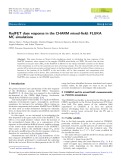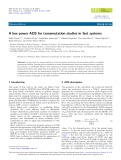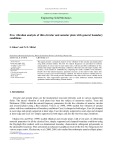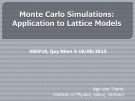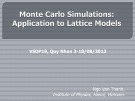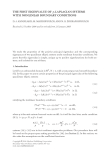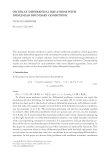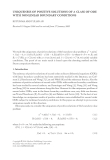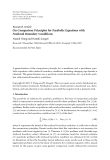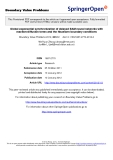VSOP19, Quy Nhon 3-18/08/2013
Ngo Van Thanh, Institute of Physics, Hanoi, Vietnam.
Part II. Monte Carlo Simulation Methods
II.1. The spin models II.2. Boundary conditions II.3. Simple sampling Monte Carlo methods II.4. Importance sampling Monte Carlo methods
A Guide to Monte Carlo Simulations in Statistical Physics
Monte Carlo Simulation in Statistical Physics: An Introduction
D. Landau and K. Binder, (Cambridge University Press, 2009).
Understanding Molecular Simulation : From Algorithms to Applications
K. Binder and D. W. Heermann (Springer-Verlag Berlin Heidelberg, 2010).
Frustrated Spin Systems
D. Frenkel, (Academic Press, 2002).
Lecture notes PDF files : http://iop.vast.ac.vn/~nvthanh/cours/vsop/ Example code : http://iop.vast.ac.vn/~nvthanh/cours/vsop/code/
H. T. Diep, 2nd Ed. (World Scientific, 2013).
II.1. The spin models
Introduction Spin model = spin kind + lattice structure (with including the dimension)
Spin kinds :
Ising
XY
Lattice structure :
Heisenberg
Simple cubic (SC)
Body center cubic (BCC)
Face center cubic (FCC)
Stacked triangular (hexagonal)
…
Dimensions : 2D, 3D or films
n-vector model The hamiltonian
(2.1)
n : number of conponent
n = 0 : The Self-Avoiding Walks n = 1 : Ising model n = 2 : XY model n = 3 : Heisenberg model
exchange interaction J
: Ferromagnetic interaction : Antiferromagnetic interaction : Spin glass
The sum is taken over
nearest neighbours spin pair
next nearest neighbours spin pair …
Ising spin model The hamiltonian
the probability that the system is in state s
(2.2)
For the ferromagnetic Ising model on 2D simple cubic lattice
(2.3)
The energy
(2.4)
XY spin model
The hamiltonian
This is the special case of the n-vector model, for n = 2
Using polar coordinate, with and
(2.5)
the system in a external magnetic field
(2.6)
(2.7)
Heisenberg spin model
The hamiltonian with
This is the special case of the n-vector model, for n = 3
The equation of motion in the continuum limit
(2.8)
(2.9)
The Potts model The standard Potts model, spin
: is the Kronecker delta
(2.10)
(2.11)
II.2. Boundary conditions
Periodic boundary condition (PBC)
Free boundary condition Using for a thin-film geometry
i
s s e n k c h t
m
l i f
Applying the free boundary condition on z-direction only Use PBC on (x, y) plane
II.3. Simple sampling Monte Carlo methods
Comparisons of methods for numerical integration of given functions:
Simple methods Consider a definite integral
(2.12)
y y0
f(x)
draw a box extending from a to b and from 0 to y0 Using random numbers drawn from a uniform distribution drop N points randomly into the box count the number N0 which fall below f(x) An estimate for the integral
(2.13)
0
x a b
Crude method
choose N values of x randomly, then calculate f(x)
(2.14)
Intelligent methods : control variate method
(2.15)
where
selects a integrable function
Simulation of radioactive decay : Consider sample of N nuclei which decay at rate
(2.16)
the rate of decay
(2.17)
the nuclei is chosen randomly The number of undecayed nuclei
Simulation
Dividing the time into discrete intervals
N0 : the initial number of nuclei, related to the ‘half-life’ of the system
during the time interval, test for decay of each undecayed nucleus
Determine the number of undecayed nuclei
Increasing the time step, then repeat the process
Program structure N = N0 ; NP = N0
LOOP from 1 to NP ! Loop over each remaining parent nucleus
LOOP from (t = dt) to Tmax , step dt
R = uniform_RandomNumber()
! 0 R 1
IF ( R < λ dt ) THEN
N = N-1
END IF
END LOOP over nuclei
NP = N
Record t, N
END LOOP over time
Source : radioactive_decay.f90
PROGRAM RADIOACTIVE_DECAY IMPLICIT NONE REAL :: t,tmax,dt,r,lambda INTEGER :: n,n0,np,nt,i ! CALL RANDOM_SEED() n0 = 1000; tmax = 50.0 dt = 0.1; lambda = 0.1 n = n0; t = 0.0 DO WHILE (t <= tmax .AND. n > 0) t = t + dt np = n DO i = 1,np CALL RANDOM_NUMBER(r) IF (r < lambda*dt) n = n - 1 END DO nt = NINT(n0*exp(-t*lambda)) print*,t,n,nt END DO END PROGRAM RADIOACTIVE_DECAY
Finding the groundstate of a hamiltonian Consider a system of Ising spins
Algorithm
Randomly chosen an initial state of the system Choose a random site on the lattice Try to overturn the spin, determining the change in energy if the energy is lowered, then accept the overturn of the spin otherwise it is left unchanged, go to the next site.
We can use different initial configurations, one tests to see
the system is then either in the groundstate or in some metastable state.
if the same state is reached as before if a lower energy state is found.
Source : groundstate.f90
PROGRAM GROUNDSTATE IMPLICIT NONE INTEGER, PARAMETER :: N = 10 REAL,DIMENSION(n,n) :: S INTEGER :: i,j,k,l,ip,im,jp,jm REAL :: r,e1,e2,temp ! initial configuration CALL RANDOM_SEED() CALL RANDOM_NUMBER(S) DO i = 1,n DO j = 1,n IF (S(i,j) > 0.5) THEN S(i,j) = 1.0 ELSE S(i,j) = -1.0 ENDIF ENDDO ENDDO print*,0,etot()
DO l = 1,60 ! Simulation DO k = 1,40 CALL RANDOM_NUMBER(r) i = INT(r*float(n))+1 CALL RANDOM_NUMBER(r) j = INT(r*float(n))+1 ! periodic boundary condition ip = i + 1; im = i - 1 jp = j + 1; jm = j - 1 IF (ip > n) ip = 1; IF (im < 1) im = n IF (jp > n) jp = 1; IF (jm < 1) jm = n ! calculate the energy e1 = -S(i,j)*(S(ip,j)+S(im,j)+S(i,jp)+S(i,jm)) e2 = -e1 IF (e2 <= e1) S(i,j) = -S(i,j) ENDDO print*,l,etot() ENDDO
CONTAINS ! list of subroutine/function REAL FUNCTION etot temp = 0.0 DO i = 1,n ip = i + 1; im = i - 1 IF (ip > n) ip = 1 IF (im < 1) im = n DO j = 1,n jp = j + 1; jm = j - 1 IF (jp > n) jp = 1 IF (jm < 1) jm = n temp = temp & - S(i,j)*(S(ip,j)+S(im,j)+S(i,jp)+S(i,jm)) ENDDO ENDDO etot = 0.5*temp/float(n*n) END FUNCTION etot ! END PROGRAM GROUNDSTATE
Generation of random walks Introduction
path formed by randomly adding new bonds to the end of the existing walk
A random walk consists of a connected
The mean-square end-to-end distance
(2.18)
: critical exponent
: non-universal constants
The partition function
: correction to scaling exponent
(2.19)
: an effective coordination number
Random walks (RW)
used for the description of diffusion phenomena
the end-to-end distance
(2.20)
Simulation of the simple random walk
Picking a starting point
Generating a random number to determine the direction of each subsequent
Calculating the end-to-end distance
non-reversal random walk (RNNW)
Performing a statistical analysis of the resultant distribution
The choice of the (n + 1) step from the nth step of a return to the point reached at the (n - 1) step is forbidden
! number-of-samples ! initial position ! number of step
id = INT(r*4.0) SELECT CASE(id) CASE (0) x = x + 1 CASE (1) x = x - 1 CASE (2) y = y + 1 CASE (3) y = y - 1 END SELECT
Algorithm of random walks DO i = 1 to ns x = 0; y = 0 DO j = 1 to N ENDDO accumulate-results ENDDO
the end-to-end distance
Source : randomwalk.f90
INTEGER, PARAMETER :: ns = 1000,n = 100 INTEGER :: i,j,x,y,id REAL :: r,d,d2,temp CALL RANDOM_SEED() d = 0.0; d2 = 0.0 DO i=1,ns x = 0; y = 0 DO j = 1,n CALL RANDOM_NUMBER(r) id = INT(r*4.0) SELECT CASE (id) CASE (0) x = x + 1 CASE (1) x = x - 1 CASE (2) y = y + 1 CASE (3) y = y - 1 END SELECT ENDDO temp = float(x**2+y**2) d = d + sqrt(temp); d2 = d2 + temp ENDDO d = d/float(ns); d2 = d2/float(ns) print*,ns,n,d,d2
Algorithm of non-reversal random walks
! number-of-samples DO i = 1 to ns
x = 0; y = 0 ! initial position
xp = 0; yp = 0 ! previous position
! number of step DO j = 1 to N
repeat
xt = x; yt = y ! template position
generate-one-step (x; y)
until ((x xp) or (y yp))
xp = xt
yp = yt
ENDDO
accumulate-results
ENDDO
Source : nr_randomwalk.f90
PROGRAM NR_RANDOM_WALKS IMPLICIT NONE INTEGER, PARAMETER :: ns = 1000,n = 100 INTEGER :: i,j,x,y,id,xp,yp,xt,yt REAL :: r,d,d2,temp LOGICAL :: test ! CALL RANDOM_SEED() d = 0.0; d2 = 0.0 CALL NRRW() ! non-reversal random walks d = d/float(ns); d2 = d2/float(ns) print*,ns,n,d,d2 CONTAINS SUBROUTINE NRRW … END SUBROUTINE NRRW END PROGRAM NR_RANDOM_WALKS
SUBROUTINE NRRW DO i=1,ns x = 0; y = 0; xp = x; yp = y DO j = 1,N xt = x; yt = y; test = .FALSE. DO WHILE(.NOT.test) CALL RANDOM_NUMBER(r) id = INT(r*4.0) IF (id == 0) THEN x = xt + 1; y = yt ELSEIF (id == 1) THEN x = xt - 1; y = yt ELSEIF (id == 2) THEN y = yt + 1; x = xt ELSEIF (id == 3) THEN y = yt - 1; x = xt ENDIF IF ((x .NE. xp).OR.(y .NE.yp)) test =.TRUE. ENDDO xp = xt; yp = yt ENDDO temp = float(x**2+y**2) d = d + sqrt(temp); d2 = d2 + temp ENDDO END SUBROUTINE NRRW
Self-avoiding walks (SAW)
Used to probe the configurations of flexible
The walker dies when attempting to intersect
macromolecules in the solvents
a portion of the already completed walk
Picking a starting point
Simulations
Generating a random number to the different possible choices for the next step
If the new site is one which already contains a portion of the walk, then the process is terminated at the Nth step.
effective exponent
(2.21)
For , the effective exponent is then related to the true value
(2.22)
the current estimates for
(2.23)
The exponent
K. Kremer and K. Binder, Comput. Phys. Rep. 7, 261 (1988)
Using the equation (2.19), we have
(2.24)
using ‘symmetric’ values in step number
(2.25)
Algorithm of Self-avoiding walks integer lattice(-N:N;-N:N); do sample = 1 to n-of-samples step = 0; x = 0; y = 0; xc = 0; yc = 0; repeat repeat generate-one-step(xnew, ynew); until lattice(xnew, ynew) sample + 1; if lattice(xnew, ynew) = sample then terminate = true else lattice(x, y) = sample; x = xc; y = yc; lattice(x, y) = sample + 1; xc = xnew; yc = ynew; step = step + 1; endif until (terminate or step = N); accumulate-results enddo
Source: sa_walk.f90
…
PROGRAM SELF_AVOIDING_WALKS IMPLICIT NONE INTEGER, PARAMETER :: ns = 100,n = 100 INTEGER, DIMENSION(-n:n,-n:n) :: lattice INTEGER :: i,x,y,xt,yt,id,step,nn REAL :: r,d,d2,temp LOGICAL :: terminate,newsite ! CALL RANDOM_SEED() d = 0.0; d2 = 0.0 CALL SAW() ! self avoiding walks d = d/float(ns); d2 = d2/float(ns) print*,ns,n,d,d2 ! CONTAINS SUBROUTINE SAW END SUBROUTINE SAW ! END PROGRAM SELF_AVOIDING_WALKS
SUBROUTINE SAW DO i = 1,ns lattice = 0 x = 0; y = 0 step = 0; terminate = .FALSE. DO WHILE ((.NOT. terminate) .AND. (step <= n)) xt = x; yt = y nn = lattice(x+1,y) + lattice(x-1,y) & + lattice(x,y+1) + lattice(x,y-1) IF (nn == 4) THEN terminate = .TRUE. ELSE newsite = .FALSE. DO WHILE (.NOT. newsite) CALL RANDOM_NUMBER(r) id = INT(r*4.0)
IF (id == 0) THEN x = xt + 1; y = yt ELSEIF (id == 1) THEN x = xt - 1; y = yt ELSEIF (id == 2) THEN y = yt + 1; x = xt ELSEIF (id == 3) THEN y = yt - 1; x = xt ENDIF IF (lattice(x,y) == 0) newsite = .TRUE. ENDDO step = step + 1 lattice(x,y) = 1 ENDIF ENDDO temp = float(x**2+y**2) d = d + sqrt(temp) d2 = d2 + temp ENDDO END SUBROUTINE SAW
Thermal Averages by the Simple Sampling Method
The model
Consider a polymer chain,
: attractive energy between two nearest neighbor monomers
Defination
(2.26)
The distribution
number of SAW configurations of N steps with n nearest-neighbor contacts
(2.27)
number of SAW configurations of N steps with n nearest-neighbor contacts and an end-to-end vector .
The averages of interest
(2.28)
The specific heat C per bond of the chain
(2.29)
Using Eq. (2.28), we have
(2.30)
(2.31)
II.4. Importance sampling Monte Carlo methods
Introduction
Consider a spin model, the Hamiltonian is given by
used for the study of phase transitions at finite temperature
(2.32)
(2.33)
the averages
the thermal average of any observable
(2.34)
probability density
(2.35)
integrates Eq. (2.34) over all states with their proper weights
We consider a process where the phase space points are selected
according to some probability
(2.36)
(2.37)
A natural choice for
simple average
(2.38)
Algorithm (Metropolis method)
The configurations are generated from a previous state using a transition probability which depends on the energy difference between the initial and final states
The master equation of probability of the system
that is in the state n at time t
(2.39)
: is the transition rate for In the equilibrium process, the condition of detailed balance:
We have
(2.40)
The probability of the nth state occurring in a classical system
(2.41)
If we produce the nth state from the mth state
From Eqs. (2.40) and (2.41), we have
(2.42)
The choice of rate (Metropolis form)
(2.43)
: is the time required to attempt a spin-flip
Metropolis importance sampling Monte Carlo scheme
Ising model
(1) Choose an initial state
(2) Choose a site i
(3) Calculate the energy change E which results if
the spin at site i is overturned
(4) Generate a random number r such that 0 < r < 1
(5) If exp(-E/kBT) > r, flip the spin
(6) Go to the next site and go to (3)
Program structure
initialize the lattice
SUBROUTINE equilibrating ! Equilibrating process DO ieq = 1 to N_eq CALL monte_carlo_step() ENDDO END SUBROUTINE ! Averaging process SUBROUTINE averaging DO iav = 1 to N_av CALL monte_carlo_step() do-analysis ENDDO END SUBROUTINE SUBROUTINE monte_carlo_step generate-one-sweep END SUBROUTINE
Source : ising_2dsl.f90
Fortran code (ferromagnetic Ising spin model on 2D square lattice)
PROGRAM ISING_2D_SL IMPLICIT NONE INTEGER, PARAMETER :: n = 10,nms = n*n,nt = 20 REAL,DIMENSION(n,n) :: S INTEGER :: i,j,ip,im,jp,jm,ie,ia,ms,it,neq,nav REAL :: r,tmin,tmax,t,dt,e1,e2,temp REAL :: ener,magn ! CALL RANDOM_SEED() neq = 2000 nav = 4000 tmin = 0.5; tmax = 4.0
! initial configuration ! equilibrating process
! averaging process
! list of subroutines/functions
dt = (tmax-tmin)/float(nt-1) t = tmin ! DO it = 1,nt CALL spin_conf() CALL equilibrating() ener = 0.0 magn = 0.0 CALL averaging() ener = ener/float(nav) magn = magn/float(nav) print*, t,ener,magn t = t + dt ENDDO
CONTAINS … END PROGRAM ISING_2D_SL
! list of subroutines/functions
CONTAINS ! SUBROUTINE spin_conf CALL RANDOM_NUMBER(S) DO i = 1,n DO j = 1,n IF (S(i,j) > 0.5) THEN S(i,j) = 1.0 ELSE S(i,j) = -1.0 ENDIF ENDDO ENDDO END SUBROUTINE spin_conf ! SUBROUTINE equilibrating DO ie = 1, neq CALL monte_carlo_step() ENDDO END SUBROUTINE equilibrating
! Calculate the average energy per spin
SUBROUTINE averaging DO ia = 1, nav CALL monte_carlo_step() temp = 0.0 DO i = 1,n ip = i + 1; im = i - 1 IF (ip > n) ip = 1 IF (im < 1) im = n DO j = 1,n jp = j + 1; jm = j - 1 IF (jp > n) jp = 1 IF (jm < 1) jm = n temp = temp -S(i,j)*& (S(ip,j)+S(im,j)+S(i,jp)+S(i,jm)) ENDDO ENDDO ener = ener + 0.5*temp/float(n*n)
! Calculate the average magnetization per spin
temp = 0.0 DO i = 1,n DO j = 1,n temp = temp + S(i,j) ENDDO ENDDO magn = magn + abs(temp)/float(n*n) ENDDO END SUBROUTINE averaging
! periodic boundary condition
! calculate the different energy
SUBROUTINE monte_carlo_step DO ms = 1,nms ! number of Monte Carlo step CALL RANDOM_NUMBER(r) i = INT(r*float(n))+1 CALL RANDOM_NUMBER(r) j = INT(r*float(n))+1 ip = i + 1; im = i - 1 jp = j + 1; jm = j - 1 IF (ip > n) ip = 1 IF (im < 1) im = n IF (jp > n) jp = 1 IF (jm < 1) jm = n e1 = -S(i,j)*(S(ip,j)+S(im,j)+S(i,jp)+S(i,jm)) e2 = -e1 CALL RANDOM_NUMBER(r) IF (r < exp(-(e2-e1)/t)) S(i,j) = -S(i,j) ENDDO END SUBROUTINE monte_carlo_step
Ferromagnetic Ising spin model on square lattice
Energy vs temperature for N = 10
Ferromagnetic Ising spin model on square lattice
Magnetization vs temperature for N = 10
Exercises
modify the program «ising_2dsl.f90» :
Adding the calculations for specific heat and susceptibility
ener2 = ener2 + (0.5*temp/float(n*n))**2 magn2 = magn2 + (temp/float(n*n))**2
cv = float(n*n)*(ener2 – ener*ener)/t/t chi = float(n*n)*(magn2 – magn*magn)/t
For the case of three dimensions simple cubic lattice
Local energy :
e1 = -S(i,j,k)*(S(ip,j,k)+S(im,j,k)+S(i,jp,k)+S(i,jm,k) +S(i,j,kp)+S(i,j,km))
Ferromagnetic Ising spin model on square lattice
Specific heat vs temperature for N = 10
Ferromagnetic Ising spin model on square lattice
Magnetic susceptibility vs temperature for N = 10
Ferromagnetic Ising spin model on simple cubic lattice
Energy, magnetization, specific heat and susceptibility vs temperature for N = 12
Write a new program for ferromagnetic XY spin model on square
lattice
Including the calculations for specific heat and susceptibility
The local energy
e1 = -SX(i,j)*(SX(ip,j)+SX(im,j)+SX(i,jp)+SX(i,jm)) -SY(i,j)*(SY(ip,j)+SY(im,j)+SY(i,jp)+SY(i,jm))
Generate a new XY spin with random orientation
! orientation
CALL RANDOM_NUMBER(r)
PHI = 2.0*3.14159260*r SXN = COS(PHI) SYN = SIN(PHI)
Source : xy_2dsl.f90
Fortran code (ferromagnetic XY spin model on square lattice)
IMPLICIT NONE
PROGRAM XY_2D_SL
REAL,PARAMETER:: pi2 = 2.0*3.1415926
INTEGER, PARAMETER :: n = 10,nms = n*n,nt = 20
INTEGER :: i,j,ip,im,jp,jm,ie,ia,ms,it,neq,nav
REAL,DIMENSION(n,n) :: sx,sy
REAL :: r,tmin,tmax,t,dt,e1,e2,si,phi,sxn,syn,temp
REAL :: sxt,syt,ener,magn
!
CALL RANDOM_SEED()
neq = 20000
nav = 40000
tmin = 0.1; tmax = 2.0
dt = (tmax-tmin)/float(nt-1) t = tmin ! DO it = 1,nt
! initial configuration
CALL spin_conf() CALL equilibrating() ener = 0.0; magn = 0.0 CALL averaging() ener = ener/float(nav) magn = magn/float(nav) print*, t,ener,magn t = t + dt ENDDO
! list of subroutines/functions
CONTAINS
SUBROUTINE spin_conf ! DO i = 1,n DO j = 1,n CALL RANDOM_NUMBER(r) phi = pi2*r sx(i,j)=cos(phi) sy(i,j)=sin(phi) ENDDO ENDDO END SUBROUTINE spin_conf ! SUBROUTINE equilibrating DO ie = 1, neq CALL monte_carlo_step() ENDDO END SUBROUTINE equilibrating
+ sx(i,jp) + sx(i,jm)) &
+ sy(i,jp) + sy(i,jm))
SUBROUTINE averaging DO ia = 1, nav CALL monte_carlo_step() temp = 0.0 DO i = 1,n ip = i + 1; im = i - 1 IF (ip > n) ip = 1 IF (im < 1) im = n DO j = 1,n jp = j + 1; jm = j - 1 IF (jp > n) jp = 1 IF (jm < 1) jm = n temp = temp - sx(i,j)*(sx(ip,j) + sx(im,j) & - sy(i,j)*(sy(ip,j) + sy(im,j) & ENDDO ENDDO
ener = ener + 0.5*temp/float(n*n) sxt = 0.0; syt = 0.0 DO i = 1,n DO j = 1,n sxt = sxt + sx(i,j) syt = syt + sy(i,j) ENDDO ENDDO magn = magn + sqrt(sxt**2 + syt**2)/float(n*n) ENDDO END SUBROUTINE averaging
! periodic boundary condition
SUBROUTINE monte_carlo_step DO ms = 1,NMS CALL RANDOM_NUMBER(r) i = INT(r*float(n))+1 CALL RANDOM_NUMBER(r) j = INT(r*float(n))+1 ip = i + 1; im = i - 1 jp = j + 1; jm = j - 1 IF (ip > n) ip = 1 IF (im < 1) im = n IF (jp > n) jp = 1 IF (jm < 1) jm = n
! calculate the local energy
sxt = sx(ip,j)+sx(im,j)+sx(i,jp)+sx(i,jm) syt = sy(ip,j)+sy(im,j)+sy(i,jp)+sy(i,jm) e1 = -sx(i,j)*sxt - sy(i,j)*syt CALL RANDOM_NUMBER(r) phi = pi2*r sxn=cos(phi) syn=sin(phi) e2 = -sxn*sxt -syn*syt CALL RANDOM_NUMBER(r) IF (r < exp(-(e2-e1)/t)) THEN sx(i,j) = sxn sy(i,j) = syn ENDIF ENDDO END SUBROUTINE monte_carlo_step ! END PROGRAM XY_2D_SL
Ferromagnetic XY spin model on square lattice
Energy and magnetization vs temperature for N = 10
There exist two phases
A low-temperature-phase with a quasi-long range order, where most spins are aligned and the correlation-function decays with a power law An unordered high-temperature-phase where the correlation-function decays exponentially
The phase transition is called «Kosterlitz-Thouless transition»
Counterclockwise vortices
Write a new program for ferromagnetic Heisenberg spin model on two
dimensions square lattice
The local energy
e1 = -SX(i,j)*(SX(ip,j)+SX(im,j)+SX(i,jp)+SX(i,jm)) -SY(i,j)*(SY(ip,j)+SY(im,j)+SY(i,jp)+SY(i,jm)) -SZ(i,j)*(SZ(ip,j)+SZ(im,j)+SZ(i,jp)+SZ(i,jm))
Generate a new Heisenberg spin with random module and orientation
! orientation
CALL RANDOM_NUMBER(r)
! projection of SZ
PHI = 2.0*3.14159260*r CALL RANDOM_NUMBER(r)
SZN = 2.0*r-1.0 SI = SQRT(1-SZN*SZN) SXN = SI*COS(PHI) SYN = SI*SIN(PHI)
For two dimensions triangular lattice
The local energy
e1 = -S(i,j)*(S(ip,j)+S(im,j)+S(i,jp)+S(i,jm) + S(ip,jm)+S(im,jp))
For 3D stracked triangular lattice
e1 = -S(i,j,k)*(S(ip,j,k)+S(im,j,k)+S(i,jp,k)+S(i,jm,k) +S(ip,jm,k)+S(im,jp,k) +S(i,j,kp) +S(i,j,km))
Source : ising_2dtl.f90
Fortran code (ferromagnetic Ising spin model on triangular lattice)
IMPLICIT NONE
PROGRAM ISING_2D_TL
INTEGER, PARAMETER :: n = 10,nms = n*n,nt = 40
REAL,DIMENSION(n,n) :: S
REAL :: r,tmin,tmax,t,dt,e1,e2,temp
INTEGER :: i,j,ip,im,jp,jm,ie,ia,ms,it,neq,nav
REAL :: ener,magn
!
CALL RANDOM_SEED()
neq = 20000
nav = 40000
tmin = 1.0; tmax = 6.0
dt = (tmax-tmin)/float(nt-1) t = tmin ! DO it = 1,nt CALL spin_conf() ! initial configuration CALL equilibrating() ener = 0.0; magn = 0.0 CALL averaging() ener = ener/float(nav) magn = magn/float(nav) print*, t,ener,magn t = t + dt ENDDO CONTAINS ! list of subroutine/function
SUBROUTINE spin_conf ! CALL RANDOM_NUMBER(S) DO i = 1,n DO j = 1,n IF (S(i,j) > 0.5) THEN S(i,j) = 1.0 ELSE S(i,j) = -1.0 ENDIF ENDDO ENDDO END SUBROUTINE spin_conf ! SUBROUTINE equilibrating DO ie = 1, neq CALL monte_carlo_step() ENDDO END SUBROUTINE equilibrating
SUBROUTINE averaging DO ia = 1, nav CALL monte_carlo_step() temp = 0.0 DO i = 1,n ip = i + 1; im = i - 1 IF (ip > n) ip = 1 IF (im < 1) im = n DO j = 1,n jp = j + 1; jm = j - 1 IF (jp > n) jp = 1 IF (jm < 1) jm = n temp = temp - S(i,j)*(S(ip,j)+S(im,j) & +S(i,jp)+S(i,jm) + S(ip,jm)+S(im,jp) ) ENDDO ENDDO ener = ener + 0.5*temp/float(n*n)
temp = 0.0 DO i = 1,n DO j = 1,n temp = temp + S(i,j) ENDDO ENDDO magn = magn + abs(temp)/float(n*n) ENDDO END SUBROUTINE averaging
! calculate the energy
+ S(ip,jm)+S(im,jp) )
SUBROUTINE monte_carlo_step DO ms = 1,NMS CALL RANDOM_NUMBER(r); i = INT(r*float(n))+1 CALL RANDOM_NUMBER(r); j = INT(r*float(n))+1 ! periodic boundary condition ip = i + 1; im = i - 1 jp = j + 1; jm = j - 1 IF (ip > n) ip = 1 IF (im < 1) im = n IF (jp > n) jp = 1 IF (jm < 1) jm = n e1 = -S(i,j)*(S(ip,j)+S(im,j)+S(i,jp)+S(i,jm) & e2 = -e1 CALL RANDOM_NUMBER(r) IF (r < exp(-(e2-e1)/t)) S(i,j) = -S(i,j) ENDDO END SUBROUTINE monte_carlo_step END PROGRAM ISING_2D_TL
Ferromagnetic Ising spin model on 2D triangular lattice
Energy vs temperature for N = 10
Ferromagnetic Ising spin model on 2D triangular lattice
Magnetization vs temperature for N = 10

